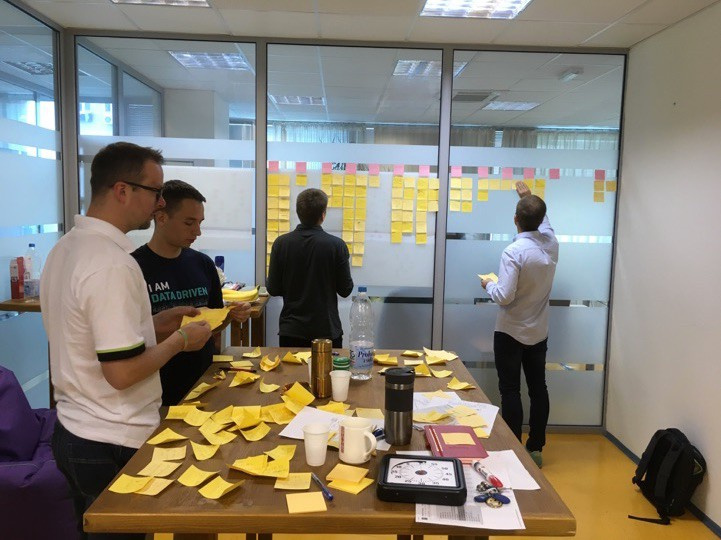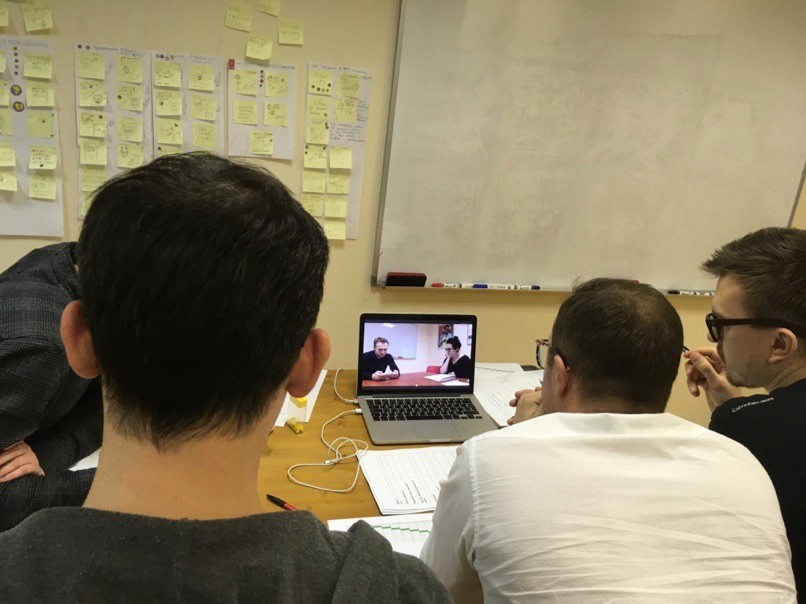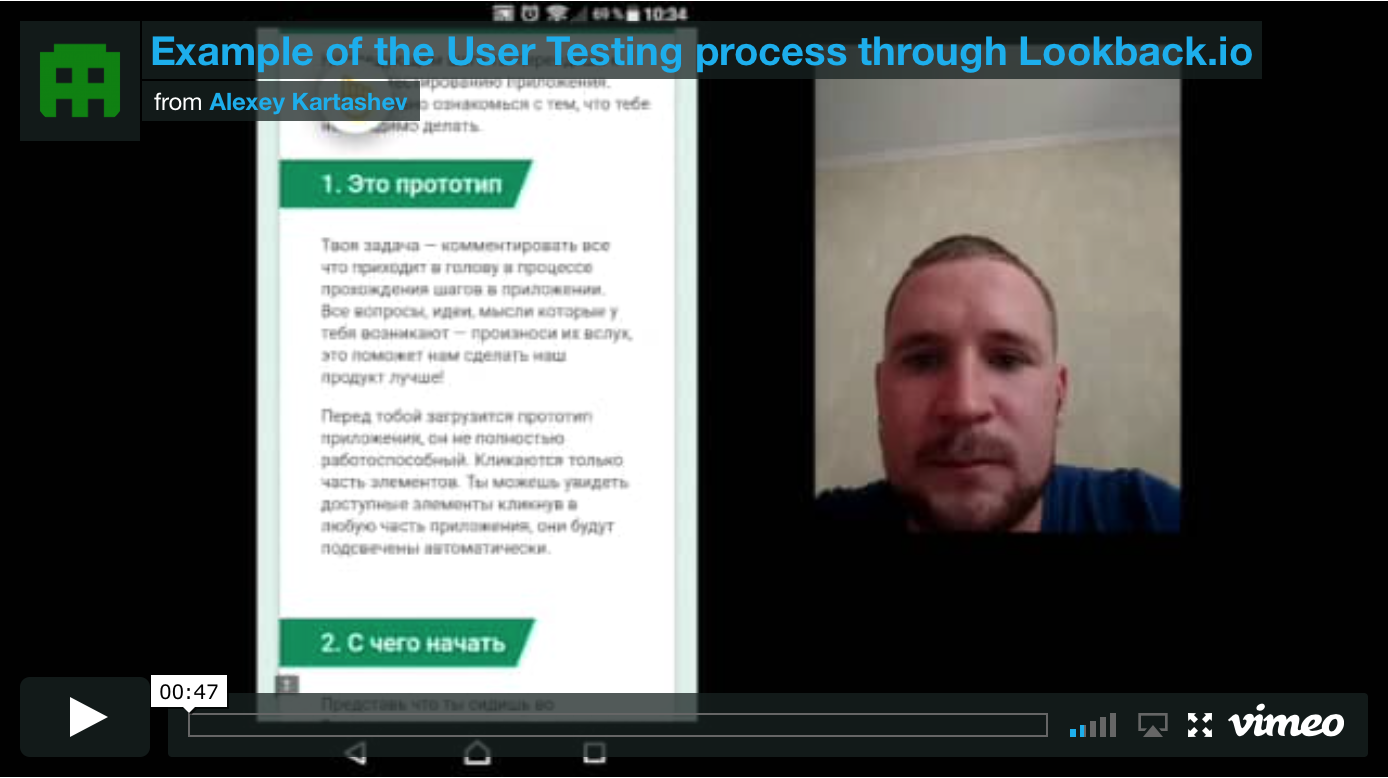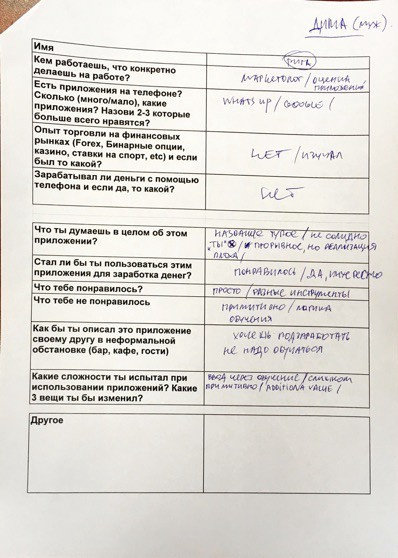How to check a business idea for $ 75. Ask Drosophila Flies
This article will first of all be interesting to those who are tired of developing things, while not understanding how they work. Or to draw designs, to give to the development, and to get in the end only static images for the portfolio. The described process can be a revelation for business owners who have come to the conclusion that the team is working from morning to evening, but the business is not growing.
You have the opportunity in less than a day to get feedback from live users, and you will spend only $ 75 .
](https://habrastorage.org/web/56b/c83/f3b/56bc83f3b8804370953a1801257107e4.jpeg)
Drosophila fly. A source
Design approaches to solve business problems
A couple of years ago, I became interested and began to dive into the themes of design thinking and creating customer-oriented products. Also over the past year I have spent a series of Design Sprints, as a result of which we have come to a working process that everyone can use.
You can familiarize yourself with what is Design Sprint , about specific applications of it by our compatriots , or read a couple of books that will give an understanding of why this is necessary. Links to my shortlist of books can be found at the end of the article.
In order not to load the head with details, just remember: in 5 days, or even less, to really work out and prepare a prototype of a new product and test it on users. Without hackathons that require the team to lock themselves in the room for 24 hours. In this format, people are not able to work constantly. I will give a tool that will become part of the product creation culture in the company and teach you how to get feedback from prototypes cheaply, quickly, and an order of magnitude better than your current approach.

Sprint design in action
Why is this all?
From my own experience I will say that there is no problem with the production of new ideas in companies. Colleagues and users are ready to flood you with ideas around the clock, offer a bunch of cool solutions and insist on their urgent implementation. It happens in the format “Look what a cool feature I found! Let's do it with us? ”
I will not discourage such an approach, it sometimes works and allows the business to grow and achieve goals.
There is one huge flaw in this approach: you learn very slowly . You simply go through your own or other people's ideas in a random order, and get feedback through the consistently expensive implementation and development of each of them.
Every business is a science lab, and you are scientists in it.
Imagine that you are a team of scientists, immersed in science. Your task is to empirically derive a set of laws and models that will prove the viability of your hypothesis both in the laboratory and in the field.
At the moment you are most likely just trying to copy the competitor's formula, and poke your finger in the right set of ingredients. Or you invent your new, breakthrough formula from your head. Now you do it slowly, often mistaken, and initially test the result in a sterile tube, on yourself .
As soon as it seemed that something similar to the expected result is happening in the test tube - release your idea to the world, spend a lot of money on creating a pipeline with the product of your research, set up delivery logistics and carry out expensive marketing campaigns. If you poke successfully - then in the field it will work, and you will get a profit. If not, the pipelines are already built, logistics is set up and advertising budgets are spent, why change something?
Now let us remember that you are scientists and before you start production you, at a minimum, check your formula on flies of fruit flies. They cost cheap, are born and age in 1 day and, like us, are representatives of the carbon form of life. And when the result of your work shows a positive effect on flies, you can continue on mice (MVP-approach), then you will be ready to assemble a test group of people, etc. The cycles of your training from completely failed ideas to finding the one that brings you closer to your goal - days, not weeks or months. Flies will answer the most important question - what should (not) do next ?
And every day you learn , quickly and qualitatively enough to choose the direction of activity. Among other things, you most likely do not want to kill flies by millions, stepping on the same rake. It is not humane. A few dozen will be enough. And here you are at the level of reflexes more responsive to their work.
Some theory
Before continuing, I have to give a bit of theory in order to eliminate possible fundamental errors and emerging issues.
The right prototype and how to create it.
In the approaches of Design Thinking and Design Sprint a very important part of the methodology is the question of prototyping. The process of creating fast, simple, moderately dirty prototypes that answer the main question: does the consumer need it or not?
Returning to the laboratory research analogy, you will not make packaging for your product and come up with a beautiful name for it until you receive a positive laboratory test result.
To create a prototype, you usually need to spend a little more time than you usually spend on explaining your ideas to the designer and the developer. But most importantly - you will get the opportunity to receive quick feedback from your potential customers! Prototypes can slow us down to speed up later.

An example of a prototype application assembled in a few hours in Keynote
If you need to develop an application interface, then Keynote / PowerPoint suits you 100%. IMPORTANT: Do not use Sketch / Photoshop or any other professional prototyping tool; you hang out at the creation stage for days, instead of building your prototype in a matter of hours.
Keynote / PowerPoint’s rectangles and the ability to paint them in the right color is enough to convey the core value of your product to the prototype client. Believe me!
And now the prototype has been assembled, I usually have 20–30 Keynote slides, it remains to collect the client’s entire path into Invision . This is not necessary, since you can simply open the presentation on your phone and it is already interactive. But this step will be critical if you want to make the testing process fast and scalable.
How many people do you need to get constructive feedback (answer: 5)
Jacob Nielsen, the author of a series of books on web design in the 2000s, empirically derived a law on 5 users to whom you need to show your product. In my experience, I will tell you that this law works. You can find 20 people, but the most valuable / critical feedback you get is from 5, the rest will be noise.
What questions to ask users
The prototype is ready, you have found 5 people and now it is time to get feedback.
Ask the right questions and you will get helpful answers. You can take the list of questions we use below by copying and adapting them to your task.
Feedback: problems and my experience
It so happened that I live and work in a country in which the native language is not English and not Russian. Physically, I am in sunny Montenegro, and before me every time the question arose “how can we recruit those 5 people for the test?”, Which will give feedback on our product. Making a prototype in Serbian-Montenegrin is an interpreter and takes several days.
What we tried:
- Usability testing by an external agency;
- The corridor test in the office on their own colleagues;
- Search for external candidates through social networks and inviting them to the Moscow office to collect feedback;
- Search for participants through paid advertising in social networks and monitor the results through the camera of a laptop or phone;
- And finally, the process requires a minimum of financial investments and which can be learned very quickly .
1. Usability testing by an external agency
I added this option, as I am sure that for many this solution seems to be the easiest. You find an agency that can do a usability test, perhaps even using Eye-tracking or some other “magic” technology. You pay an agency from a thousand dollars for a multi-page document. Perhaps someone will even read this document entirely and, having found there confirmations of their points of view, will push changes in your product. I already expect rays of hatred from the owners and employees of usability agencies, but this is my personal experience, maybe I was looking badly or I was not lucky.
What to do:
Choose from thousands of agencies willing to do the job for you.
Pros:
It is very simple. You need to have an adequate budget, and you get a beautiful document with recommendations.
Minuses:
- Your designer will most likely disagree with a lot of recommendations and will be reluctant to deal with the correction of the comments found.
- Completed usability test does not mean that after making changes in your business, at least something will change. And the cost of services is quite high.
- Most agencies will not dive into your business, and in any case you will have to check any recommendations through A / B tests and spend time on it. You just found another “expert adviser” who will fill you in the head with extra information. I did not hear examples of products that did not become successful due to the fact that buttons of the wrong color were used, or their logo was poorly recognizable.
- You will wait from a few weeks until the recommendations are collected and beautifully decorated, and thus you will lose precious time for you.
- You may have to finish the design, or even develop your ideas before giving them to the agency, and this is money and time.
Recommendations:
The choice is yours. I have no idea what to do with such documents, just do not waste your time and money.
Cost: from 50 thousand rubles and several weeks of waiting for a document with recommendations.
2. The hallway test in the office
The fastest, cheapest and easiest way to get feedback. But, unfortunately, not the most effective. I would say that this method is better than nothing.
What to do:
Catch 5 experimental colleagues in the office. Show them your prototype, listen and record all the problems that your colleagues encountered during the testing process.
Pros:
Perhaps the fastest option. Find 5 colleagues in the hallway, ask them some questions and get feedback, what could be better? We invited colleagues, locked ourselves in a neighboring meeting and watched via Skype as they were testing our prototype. This approach is exactly for you, and it’s very exciting to watch your colleagues through the camera.
Minuses:
Professional deformation of your colleagues will necessarily affect the quality of the answers. Even if your colleague did not try your product, but only accrued wages, he already has an opinion about the company, and for the most part this leads to an average internal point of view, which you already know. As a result, the feedback is much less valuable than the feedback from external candidates.
Most of the answers will be reduced to comparison with the existing products of your company.
Recommendations:
You can try to circumvent the above problems by calling your prototype the name of a fictitious company, using other colors, explain that this is a product that is not tied to the current business or you make it for yourself. But my advice is to read further and choose more representative options.
Cost:
Free + several hours to prepare and conduct an interview.

Testing prototype on colleagues
3. Invitation to the office to test the prototype
To begin with, you need a place, time and work done in advance to find candidates. We used groups on Facebook and Vkontakte, as well as tried paid advertising on social networks.
What to do:
- Find through your chosen communication channel 5 users who are ready to come to your office.
- Agree on a visit to each of the participants, with a margin of time for unforeseen circumstances.
- Choose the interviewer and instruct you about the list of questions you need to ask. It is better if this is a team member developing a prototype, but this is not necessary.
- Set up a one-way video connection; the team should monitor the users, but not vice versa.
- Watch the results of the interview in real time and record the voiced problems in the prepared questionnaire. I will give his template below.

Real users are testing prototype in the office
Pros:
The approach works very well if you sit in the center of a big city, with most of the population speaking the same language as your prototype. You will receive extremely useful feedback.
Minuses:
- It requires training and resources of at least one person who will search for people, ring up them to discuss the details and build a schedule for their visits. It will take about half a day to arrange with all the participants, choose the right time, etc. Plus you will conduct an interview for one working day.
- If you are in a big city, then be prepared for the fact that people will be late, plus many will not be able to participate during working hours, will be asked to hold a meeting after working hours. I am not in favor of staying up late in the office, much less asking my colleagues about it.
Recommendations:
Instead of office, you can rent a coworking for 1 day, or just sit in a quiet cafe. Just check with the waiter beforehand is allowed to take on the camera, even themselves.
You can try to give the task of finding candidates and collecting feedback to the freelance student, it is likely to be cheaper.
To simultaneously record video from a laptop camera and broadcast the user's screen, you can use the Zoom.us application. On a Mac + iPhone, this works very well.
Personally, I can say that there are more problems with this approach than with any other.
Cost: from 2500 rub. (from 500 rubles as a reward for each participant) + the cost of time to search for candidates and conduct a test (1-2 days).
4. Search for participants for remote testing through paid advertising on Facebook / Vkontakte
We now turn to a more or less scalable option, when you and your team will need less participation to get feedback.
What to do:
- Write a good ad on social networks. My sample ad can be found here .
- Choose reward: for Russia the certificate is 500 rub. on Ozon.ru or $ 10 at Amazon.com is quite suitable.
- Prepare a prototype and instructions that you will send by email to potential candidates. How to do this is described below, in the " $ 75 approach ."
- To eliminate manual work with profiling, you can create a Google Forms survey that users fill out when they click on an ad.
Pros:
You can easily customize user segmentation and select only those who are really interested in you. If you need men 35–45 years old from the Moscow region who have ever been interested in the products of your competitors, then Facebook will find you like this and you can get feedback from them. Here you can exclude those who already use your application.
In general, you will only have to wait for the applications that have responded and send them a reward on completion.
Minuses:
- Whatever good ad you have written, it will not be enough to click on it, and those who pass the test will be calculated in units.
- High price. Be prepared to spend from $ 100 to find ~ 20 potential participants.
- Users can start reading and invite their friends who are not suitable for you, they will need to be cut off at the level of the registration form for testing or after the final feedback.
Recommendations:
I automated a part of work with cheaters and sending the task through Zapier. After filling out the questionnaire, I chose only the Central Asia that interests me through the fields of age and sex, and automatically sent them a task by email. The filter responses came to me in Slack and all I could do was send the rewards.
Price:
~ 8000 rub. ($ 100 for advertising and $ 50 for each passed the test) + a few hours of setup and a couple of days waiting for the results.
5. “75 Dollar Approach”, scalable and fastest
Finally, a process that allows you to test any prototype with minimal participation. Below is detailed instructions on how to start using this approach with hints and descriptions of possible “pitfalls”.

An example of part of the prototype testing process on external candidates
What to do:
- Compose your “Welcome Survey” in Google Forms, with questions about the respondent. At this step, your task is to become familiar with the user, find out who he is working with and what experience he has. The questions here and further are constructed in order of increasing complexity, so as not to scare off a potential candidate. After completing this survey on the “Thank you” page, place a link to your prototype in Invision. An example of such a survey .
- I recommend to remove the horizontal scroll from the Invision-prototype, otherwise many will brush from side to side and the whole feedback will be smeared, because they will see the entire prototype, not understanding what is happening.
- As a final step of the prototype, simply transfer the user to the “Final” survey. An example of questions can take here .
- "Wrap" your first survey in the project in the service Lookback.io . I think you yourself can easily handle how to do it. It will be easier for you to find users regardless of the platform, so it’s better to do two projects at once: iOS and Android. But for the purity of the results, I still recommend searching for people on iOS, the platform works best in it.
- Unfortunately, Lookback.io still does not know how to divide users into 2 versions by their UserAgent, so turn both iOS / Android links into one via hyperurl.co or its analogs.
- Create instructions on how to pass the test, which will be sent to candidates. You can take a look at my example .
- Create an ad in UpWork . We have tried many sites, but it is UpWork that works best for this process. I write the title and a brief description in English, and then I write in the language of the prototype. As a reward, use $ 15 through the service, usually this is enough.
- Find 30-40 participants to whom you would like to show your prototype and invite them to work. Segment by country, cost per hour, and just choose the ones you like. In my experience, 20–30% will respond to your proposal, and most of them will be ready to complete the task within a few hours. Send the created instruction and wait for the result. To save time, cut off users who will pass the prototype tomorrow (not today).
- Get feedback. We print the survey on paper and each team member fills it individually for each user in our video viewing sessions.

An example of a user survey team filled in by user
Pros:
From creating a prototype in Invision to getting the first constructive response, it takes several hours. In one day, you will collect the 5 answers you need and be ready for the next iteration, or for development.
Lookback.io is able to send notifications to Slack when feedback is received, it is convenient and you do not need to manually check whether new answers came.
And finally, this is very exciting! Each member of the team can touch the real users, I do not just develop for the uncle, not seeing the result.

The process of collecting feedback from real users
Minuses:
Preparatory work is required, in this approach more technological than in any of the above described. Be prepared that some users will not want to install third-party applications for testing. I do not persuade them, but simply refuse to work. You will have a queue of people willing to complete the task without additional questions.
Cost:
~ 4000 rub. ($ 75), several hours of work on the preparation and the result on the same day. You can start with the trialback version of Lookback.io, and then pay $ 29 per month for a license for 1 user.
What to do next?
You have received feedback from five people. Those same "flies" that will give you direction for further action. Get your team together on Friday night, or any other day, and start watching video recordings. If at least two of the participants pointed to the same problem - you need to fix it, improve, change.
Write down every problem next to the names of the respondents. Circle the repeating ones with a colored marker and place a mark with the number of intersections. The more times you hear about the problem, the higher the priority.

Selection of problems and their prioritization based on feedback from real users
Once you have selected the top priority issues for improvement, correct them. Just do not try to edit something else, you just postpone the launch of your product. Every next test and adaptation should take less time. Your task is to get feedback without intersections.
In just one day, you will receive the most critical comments, which at times increase the chances of a life of your idea . As a bonus, you will have the answer why it works or does not work .

How to choose the method you decide. The main thing - remember about those same flies, the faster you go wrong or find the right direction of movement, the better. Do not develop everything, test your business ideas on real users and make really good products!
Advice: if you are a designer or developer and are not sure of the need for a solution that you need to develop, then you can, at your own expense, carry out the test indicated above, and thereby implement the described approach, proving it is not practical :)
At the beginning of the article I deliberately missed a lot of details regarding the process of Design Sprint, you can read in the highly practical book The Design Sprint . You will learn the basics of Design Thinking and how, for example, to make a prototype of a hotel from cardboard and chopsticks in the book Change By Design or in the Russian version of the high-quality translation of the same book Design Thinking in Business .
')
Source: https://habr.com/ru/post/328686/
All Articles